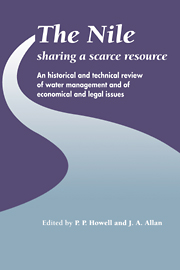 The Nile: Sharing a Scarce Resource
The Nile: Sharing a Scarce Resource Book contents
- Frontmatter
- Contents
- Preface
- List of Contributors
- Orthography
- Units and Conversion Factors
- Introduction
- I Environmental history of the Nile and its management
- II Nile management and factors affecting future management
- III Future utilisation of Nile waters
- IV Economic, international and legal issues
- 14 Evolving water demands and national development options
- 15 The Nile Basin: water management strategies
- 16 History of the Nile Basin and Lake Victoria basins through treaties
- 17 Principles and precedents in international law governing the sharing of Nile waters
- 18 Law and the River Nile: emerging international rules and the Sharia'h
- 19 Developing policies for harmonised Nile Waters development and management
- Index
15 - The Nile Basin: water management strategies
Published online by Cambridge University Press: 05 February 2012
- Frontmatter
- Contents
- Preface
- List of Contributors
- Orthography
- Units and Conversion Factors
- Introduction
- I Environmental history of the Nile and its management
- II Nile management and factors affecting future management
- III Future utilisation of Nile waters
- IV Economic, international and legal issues
- 14 Evolving water demands and national development options
- 15 The Nile Basin: water management strategies
- 16 History of the Nile Basin and Lake Victoria basins through treaties
- 17 Principles and precedents in international law governing the sharing of Nile waters
- 18 Law and the River Nile: emerging international rules and the Sharia'h
- 19 Developing policies for harmonised Nile Waters development and management
- Index
Summary
Introduction and background
The Nile Basin is one of the most studied natural resource systems in the world. The hydrological studies and basin-wide reviews completed in the past were produced under different historical and regional circumstances. Some of the most comprehensive by Egyptian and British engineers (Egyptian Government (Macdonald) 1921, McGregor 1945, Morrice and Allan 1958, and Hurst 1933, Hurst et al 1946, Hurst 1952) were prepared when a single power, Britain had significant influence over five of the Nile Basin states and as a result a more comprehensive and integrated approach was taken in these reports and publications than has been possible since.
With the change of government in Egypt in 1952 and the cataclysm in international and regional relations following Suez in 1956 a new approach to resource security was adopted by Egypt which involved the building of a major water storage structure, the Aswan Dam at its southern border. This was completed with Soviet support and Egypt continued its Soviet orientation until 1973 when Sadat turned to the United States for practical economic and strategic support. The building of the Aswan Dam was not just a feature of water management, however, it was also very significant in terms of future political relations in the Basin.
At first sight the structure may seem to be of importance only to Egypt and Sudan, the main users of Nile water in the mid-1950s and still by far the major users.
- Type
- Chapter
- Information
- The Nile: Sharing a Scarce ResourceA Historical and Technical Review of Water Management and of Economical and Legal Issues, pp. 313 - 320Publisher: Cambridge University PressPrint publication year: 1994
- 1
- Cited by


